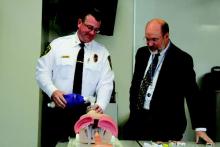Intranasal (IN) naloxone, which is not approved by the Food and Drug Administration, is the most widely used method of administering naloxone by police and other first responders. They use a standard dose of 0.4 contained in a syringe with an atomizer, delivering one 0.2 mg dose per nostril. Another option is the autoinjector that provides an injection of naloxone with a speaker that provides instructions guiding the user. This option was approved by the FDA in 2014.
Evidence that the intranasal form is effective dates back to 2005, with a study that found a dose of 2 mg/2 cc in a prefilled syringe delivered with an atomizer by Denver paramedics was effective in 43 of 52 (83%) people. IV naloxone was needed in nine individuals who did not respond to the IN dose, including five who had nasal pathology (J. Emerg. Med. 2005; 29:265-71). In a more recent study that randomized 100 patients admitted to an emergency department with an opioid overdose to a lower IN dose (0.4 mg) or IV naloxone, the IN route proved as effective as the IV route in reversing respiratory depression and central nervous system effects (Arch. Med. Sci. 2014;10:309-14).
Broad effectiveness found
Dr. Collins said the various options have advantages and drawbacks, and if only one option is available for whatever reason, “they all work.” IM and IV formulations have the fastest onset of action, are the least expensive, and are FDA-approved but carry the risk of a needlestick injury. IN naloxone is not FDA-approved, and might have a slightly slower and less predictable effect but has no risk of a needlestick injury. In addition, IN naloxone is inexpensive and easy to use. The recently FDA-approved Evzio autoinjector pre-filled with naloxone solution, administered IM or subcutaneously, has a faster onset with a predictable effect and no risk of a needle stick. It also includes audio instructions that walks the user through its use. But it costs about $400 per kit, which is a drawback, he said.
Dr. Savage pointed out that administering naloxone is only part of intervening in an opioid overdose and that training is needed when naloxone is dispensed or prescribed to patients or their families. Included in such training would be when to call for help, how to identify signs of an overdose, how to position patients for rescue, understanding rescue breathing, and knowing when the admininstration of naloxone is indicated. Since naloxone wears off in about half an hour, depending on the route and other variables, people should be told that they need to call for emergency support and transport for ongoing care because many opioids end up lasting longer than the effects of naloxone.
The FDA is considering making naloxone available over the counter, but such a move will take several years. It can be provided by pharmacies in states that have a collaborative practice agreement in place that supports distribution to people addicted to opioids, their families, and friends, she said. For example, in Rhode Island, a collaborative practice agreement exists allowing Walgreens pharmacies to dispense naloxone without a prescription.
Based on an informal poll taken during the workshop, none of those in attendance had started to prescribe naloxone for their patients, although they were interested in doing so or were figuring out how to make it available. During the discussion period, barriers they cited included the time and resources needed to train people to administer naloxone, the cost, and the lack of awareness among pharmacies about their ability to obtain intranasal kits. Suggestions among participants include having nurses or pain medicine fellows provide training and education, and using videos for training. A physician at the Atlanta Veterans Affairs Medical Center pointed out that naloxone is provided at no charge to all VA hospitals, although patients might have a co-pay.
Among the resources provided by Dr. Savage and Dr. Collins for clinicians interested in providing naloxone to patients at risk of an opioid overdose and to family members of others who might witness an overdose was an American Medical Association webinar on naloxone safety, information on how to start prescribing and dispensing naloxone rescue kits, and patient information videos. More information on how to start a program is available at http://www.naloxoneinfo.org.
Dr. Savage and Dr. Collins said they had no direct commercial interests related to the topic of the workshop.


